Breasts come in all sizes and shapes. Your own breasts will even change throughout your life due to monthly menstrual cycles, menopause, childbirth, breast-feeding, age, weight changes, and birth control pills or other hormones. It is important to learn what is normal for you. This can be done by Breast Self Exams (BSE). It is easy to do, and, as the name implies, you do it yourself.
BSE is done once a month so that you become familiar with the usual appearance and feel of your own breasts. Familiarity makes it easier to notice any changes in your breasts from one month to another.
The best time to do BSE is 2 or 3 days after the end of your period, when your breasts are least likely to be tender or swollen. A woman who no longer has periods may find it helpful to pick a particular day, such as the first day of the month, to remind herself that it is time to do BSE.
If you discover anything unusual, such as a lump, a discharge from the nipple, or dimpling or puckering of the skin, you should see your doctor at once. Remember, 8 out of 10 biopsied breast lumps are not cancer.
Many women have irregular or "lumpy" breasts. The term "benign breast condition" refers to those changes in a woman's breasts that are not cancerous. Many doctors believe that nearly all women have some benign breast changes after age 30. But any change is best diagnosed by your doctor.
Discussing BSE with your doctor will help you understand the procedure better. Ask your doctor or other health professional to review with you the steps of BSE, as well as to explain what you are feeling in your breasts. This will assure you that you are doing your BSE correctly and thoroughly, and you will gain more confidence in examining your breasts.
Here is one way to do BSE:
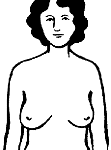
- Stand before a mirror. Inspect both breasts for anything unusual such as any discharge from the nipples or puckering, dimpling, or scaling of the skin.
The next two steps are designed to emphasize any change in the shape or contour of your breasts. As you do them, you should be able to feel your chest muscles tighten.
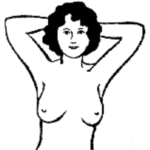
2. Watching closely in the mirror, clasp your hands behind your head and press your hands forward.
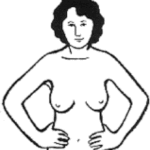
3. Next, press your hands firmly on your hips and bow slightly toward your mirror as you pull your shoulders and elbows forward.
Some women do the next part of the exam in the shower because fingers glide over soapy skin, making it easy to concentrate on the texture underneath
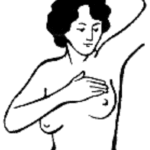
4. Raise your left arm. Use three or four fingers of your right hand to
explore your left breast firmly, carefully, and thoroughly. Beginning at the outer edge, press the flat part of your fingers in small circles, moving the circles slowly around the breast. Gradually work toward the nipple. Be sure to cover the entire breast. Pay special attention to the area between the breast and the underarm, including the underarm itself. Feel for any unusual lump or mass under the skin.
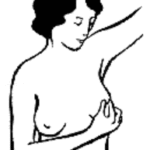
5. Gently squeeze the nipple and look for a discharge. (If you have any
discharge during the month - whether or not it is during BSE - see your doctor.) Repeat steps 4 and 5 on your right breast.
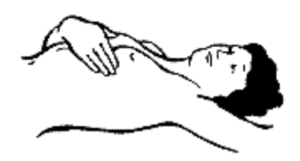
6. Steps 4 and 5 should be repeated lying down. Lie flat on your back with your left arm over your head and a pillow or folded towel under your left shoulder. This position flattens the breast and makes it easier to examine. Use the same circular motion described earlier. Repeat the exam on your right breast.
The earliest sign of breast cancer is a single painless firm to hard lump. The edges of the lump are not sharp and stretch out gradually into the surrounding tissue if felt between the fingers. Erosion of the nipple or discharge may indicate an early cancer. Late signs of cancer include an inability to move the lump which appears attached to the skin or to the deeper breast tissue. There may be puckering of the skin above the cancer or retraction of the nipple. Eventually there will be breast enlargement, hardness, inflammation and pain. Almost half of breast cancers begin in the nipple or outer and upper quarter of the breast. The earlier a cancer of the breast is discovered, the better the chances of a complete recovery.
REMEMBER, BSE IS NOT A SUBSTITUTE FOR ROUTINE THERMOGRAMS, MAMMOGRAMS OR REGULAR BREAST EXAMS
Women should have breast examinations during their routine checkups. If a breast exam is not done during that checkup, you should ask for one. During the exam, the health professional feels the breast and underarm with the fingers, checking for lumps. This is called palpation. The breasts also are checked for other changes such as dimpling, scaling, or puckering of the skin or a discharge from the nipples.
Women 40 and older should have breast examinations annually.
